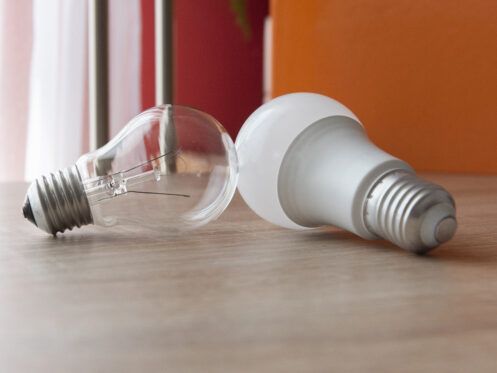There are several lighting options for your Lincoln home, and you want to ensure that you choose the best bulbs for all of them. In addition to wattage, you also have to consider the color temperature, bulb type and multiple other factors. Exploring the various considerations will ensure that you choose bulbs that offer the perfect ambiance in every room.
Light Bulb Basics
Wattage and lumens are one of the first things you look at when checking out light bulbs. Wattage indicates brightness, but it is more important to look at lumens when you are exploring LEDs and other energy-efficient bulbs. The brighter the light, the higher the lumens.
Degrees Kelvin (K) are a measurement for color temperature. This metric determines the light’s appearance. At a low Kelvin level, light is yellowish and warm. Higher Kelvins mean that the light emitted is bluish and cool. Keep in mind that this is an approximation of the light that will be emitted by flame at a certain temperature. LED bulbs do not require the same temperature range.
If you want to control the light level in a specific room, you want a dimmable bulb. Just make sure that your light is compatible with dimmer bulbs and switches.
There are a variety of light bulb shapes. To choose the best one, consider the desired aesthetic and the fixture.
There are three primary types of light bulbs. Traditional bulbs are the incandescent type. While they have less energy efficiency, they are ideal for warm light. Compact fluorescent bulbs are between LEDs and incandescent bulbs with energy efficiency, and they produce a cooler light. LEDs are generally the most energy-efficient bulbs. They come in numerous colors and are long-lasting.
Light Bulb Considerations
Lighting needs differ based on the room you are buying bulbs for. Kitchens usually have a cool white light that is focused and bright. Warm white light is ideal for an inviting living room. For your bedroom, a warmer light is best, but you might also consider a dimmer to make the lighting more flexible.
The color rendering index describes how accurately a light can show colors compared to natural light. When this index is 80 or higher, it has an accurate color representation. You want this for rooms where brighter task lighting is important, such as your bathroom or kitchen.
Light bulbs that are energy efficient last longer and use less electricity during operation. LED bulbs are the best option for energy efficiency. However, while the long-term savings are ideal, you may spend a bit more on upfront costs.
Make sure that your light bulbs are compatible with your fixtures. For example, you might need a specific type of bulb if you have a fixture with a dimmer switch.
Steps for Choosing Light Bulbs
The first step is picking the right brightness level. Think about your brightness preferences and the room’s purpose. Make sure that you are looking at the lumens. For accent lighting, you want around 450 lumens. Approximately 800 lumens are good for general lighting. When it comes to task lighting, you want around 1,600 lumens.
Next, consider the color temperature that will best complement a specific room. Cool white is best for task-oriented rooms like bathrooms and kitchens. For this, you want approximately 3,500K to 5,000K. Warm white is ideal for bedrooms, living rooms and dining rooms. Aim for 2,700K to 3,000K.
Think about the fixture, and make sure that your preferred light bulb will fit into it. For example, if you have an enclosed fixture, you might need smaller bulbs so that they will fit inside without it being too tight. With open fixtures, you usually have a bit more flexibility.
Incandescent light bulbs tend to offer the warmest glow, but their lifespan is shorter than CFLs and LEDs. CFLs offer a mid-range in terms of lifespan, but it can take them a little time to achieve their full level of brightness. LEDs have the longest lifespan, and they are versatile.
Light bulbs should have the right aesthetic to complement the design of your room and the specific fixture. Look at the design and shape to ensure a good match.
Some bulbs have special features that you can take advantage of. For example, you may decide on color-changing light bulbs or smart bulbs.
Exploring Smart Light Bulbs
It’s not uncommon to have some type of smart feature in a home today, and smart light bulbs are a relatively easy place to start. These bulbs have advanced technology that allows you to customize and remotely manage your lighting environment. You can connect wirelessly via Bluetooth or your home’s Wi-Fi to control the bulbs using voice commands, mobile apps or automation platforms.
These bulbs are versatile, allowing you to adjust the color temperature and brightness. Many of them make it possible to choose from a variety of different colors so that you can frequently change the ambiance and atmosphere in a room. For example, go with purple or blue for a relaxing night watching movies, or use pink or orange to create a warm and intimate environment for a small dinner party.
You can usually set times, schedule lighting or use motion sensors with smart bulbs. This helps to simulate occupancy when you are not home to enhance security. It also improves energy efficiency.
Common Light Bulb Shopping Mistakes
There are a few mistakes that people make when they are choosing light bulbs for their homes. The first is to remember that all rooms have different needs. When you go shopping for light bulbs, consider each room individually.
Some people neglect the color temperature when shopping for light bulbs. You want the right level of coolness or warmth for your rooms. Think of the purpose for a specific room and choose the temperature that best reflects this.
When you get a new fixture, it’s common for it to come with some recommendations about the best wattages or bulb types. Start by using these recommendations, and then, expand from there so that you make the best decision.
If you have a fixture with a dimmer switch, don’t forget to ensure that your chosen bulb is compatible. When a bulb is not dimmable and you try to use it in a dimmable fixture, you may experience poor dimming performance or flickering.
Don’t solely focus on the wattage of a bulb. Make sure that you are considering the lumens when you want to get the right level of brightness.
Keep energy efficiency in mind. The most energy-efficient light bulbs tend to have a higher upfront cost. However, since they use less energy and usually last longer, they often save you money over the long term.
Lighting Professionals in Lincoln
Picking out the right light bulbs is essential to ensure proper lighting and good aesthetics throughout your Lincoln home. We can help you examine your light bulb options so that you choose the ones that provide the level of lighting that you prefer. Ask us for our electrical inspection services! Our team can also help with your heating, plumbing, electrical, cooling and drain needs.
Call John Henry's Plumbing, Heating, Air, and Electrical in Lincoln today to further explore your indoor and outdoor lighting options.

